Japanese Knotweed, Giant Hogweed, Kudzu and Water Hyacinth have become invasive after introducing to some countries from their native countries. But why and how they have become so invasive after arriving in the new regions? Let’s find the reasons.
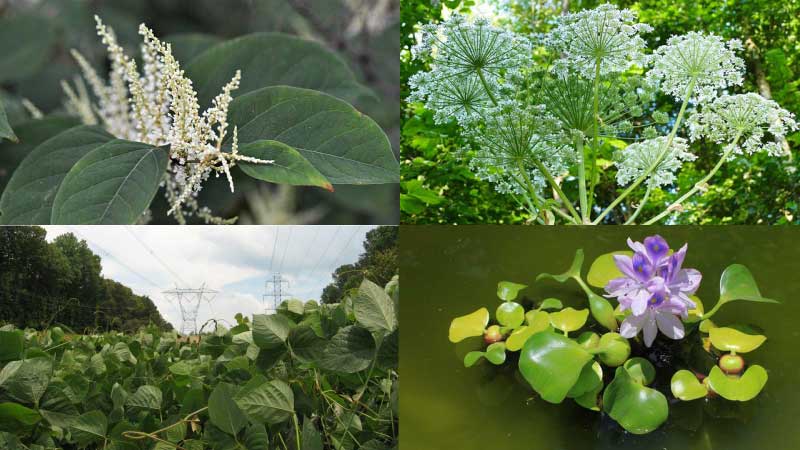
When plants are introduced to new habitats from their native habitat they may become invasive weeds. From my childhood, I have been hearing that water hyacinth was introduced in our region that has become an invasive weed for us. But recently I was very surprised when I heard about Japanese Knotweed, Giant Hogweed and Kudzu. These three weeds are also so invasive to new habitats.
Japanese Knotweed
Japanese Knotweed is a native weed of Japan, Korea, China and Taiwan. This weed is not a major problem for its native lands but after introducing to North America, Australia, New Zealand and some European countries, it has gradually become a big problem there. It was introduced as a horticultural crop in the 19th century to these countries. They planted Japanese Knotweed as a fast-growing ornamental plant in different areas and was also become popular as a plant to control soil erosion and livestock fodder. But because of its zombie-like life, it is now a big problem there. Japanese Knotweed is now a big threat to the economy of the UK. The UK have some laws to control the spread of Japanese Knotweed.
Does Japanese Knotweed have Zombie-like life? Yes, Japanese Knotweed is very tough to control. You cannot control it in generalized methods applied for killing other weeds. It can harm native biodiversity. Native wild plants can not win competing with these zombies. Property value declines due to this unwanted plant. The plant that was thought to be ornamental is now a big problem for society. But why Japanese Knotweed is so invasive?
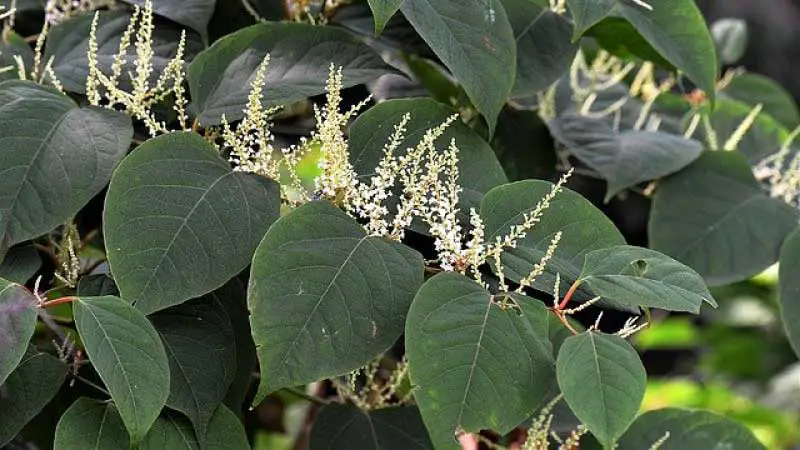
- First of all, it can grow very fast, up to 15 cm per day. It can go through even cracked 8cm thick concrete. Can you imagine that? So, you may find it anywhere, in your garden, forest, on the roadside, wetland.
- It can grow from its seed. So, the dispersal of seed can increase their population rapidly.
- It can grow from stem cuttings. So, if you are planning to cut it down to get rid of it, be aware. Cutting Japanese Knotweed will only increase the chance of growing its huge population.
- Japanese Knotweed has a large underground root system and the plant can regrow from its root after cutting its upper portion. Its root can go up to 3 meters deep which is almost equal to the height of the plant from the ground. Its rhizome type root can go up to 7 meters horizontally from the plant. So, only cutting the upper portion of the plant will not kill it.
- As Japanese Knotweed can regrow from its root again, animal grazing of above-ground part cannot kill it.
- In winter Japanese Knotweed looks to be dead but it goes to hibernating phase. After winter it becomes strong again.
- In its native habitat in Southern Asia, different pests and pathogens of Japanese Knotweed play a vital role in taking its population growth under control. But in a new habitat like the UK, Japanese Knotweed has no such natural enemies. So, Japanese Knotweed is very happy in its new habitat and can grow with full freedom.
Giant Hogweed
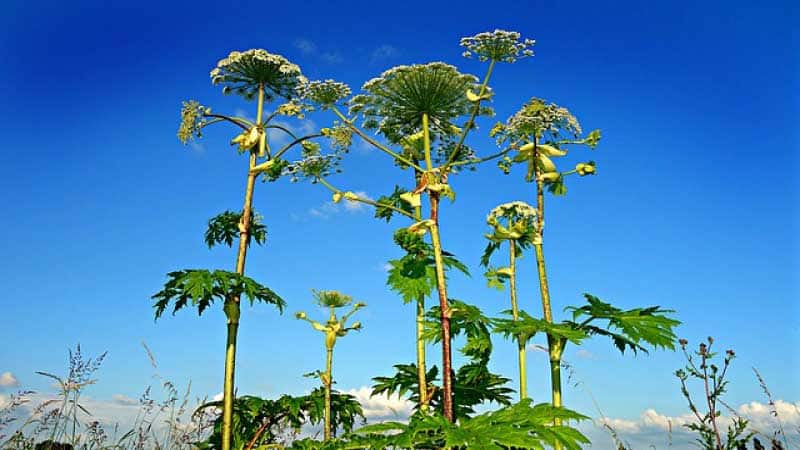
Giant Hogweed is a potentially harmful plant of the carrot family. This plant can be 3-4 meters tall. Giant Hogweed originated from the Caucasus region of Eurasia. It was taken to UK, USA and Canada in the 19th century as a garden showpiece. Beekeepers also liked Giant Hogweed for its large flower head. But now it is an invasive weed widespread in many areas of Europe and the USA. This plant looks nice when it has flowers but is poisonous for human. Sap from the stem, leaf or other parts of the plant causes severe skin irritation in sunlight. Why Giant Hogweed has become an invasive weed in new habitat? Let’s find the causes-
- Giant Hogweed can reproduce from its seed. So, it can easily be dispersed by seed.
- You cannot control this plant by cutting the above-ground part of the plant population. Like Japanese Knotweed, Giant Hogweed also can regrow from its underground root.
- As it can regrow from the root, animal grazing cannot control the population.
- You may kill the above-ground portion (Leaf, flower, stem) with some herbicides but below ground part (tuberous perennial roots) will be still alive. So, only chemical control is not enough for controlling Giant Hogweed.
- Lack of natural enemies (pests, pathogens) of Giant Hogweed in new habitat is the main cause of becoming invasive there.
Kudzu
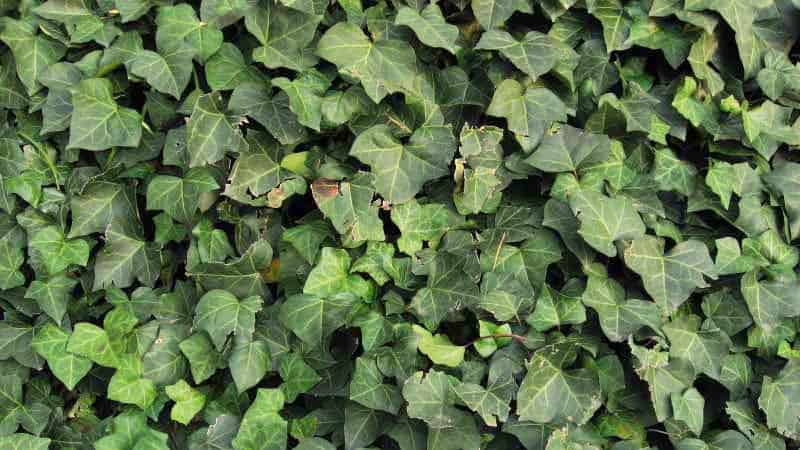
Kudzu is an aggressive vine weed that can cover any type of vegetation very quickly. Thus, it hampers agricultural production and timber growth. Kudzu suppresses native vegetation and can even kill them and thus harm the local flora and fauna. Kudzu has tri-foliate leaves and a semi-woody stem. You may be confused about kudzu with the poison ivy plant. Kudzu is a native plant of Japan, China, Taiwan and India. It was introduced to the USA in the late 19th century and was taken as an ornamental vine, inexpensive forage, and plant that can control soil erosion. Though kudzu was utilized as a medicinal plant in Asia, it has gradually become an invasive weed in the Southeastern USA. But how?
- Kudzu plant is very much fast-growing. It can grow up to 1 foot per day and can be as tall as 100 feet. Due to its fast-growing nature, it covers trees and other competitive plants and suppresses them. As a result, other plants get less light and kudzu wins in the competition. Kudzu can cover a huge land area in a short period and harms the native biodiversity.
- Kudzu is both frost and drought tolerant. That is why it can easily defeat native frost and drought-sensitive plant species.
- In the late 19th century to control soil erosion, the then government encouraged people to plant kudzu in the Southeastern USA.
- The long growing season, warm weather, abundant rainfall of the Southeastern USA facilitated kudzu to spread its territory there.
- Kudzu roots can go up to 4 meters deep. So, it can get water from that deep during the drought while some shallow-rooted native plants may struggle then.
- If you cut the above-ground portion of the kudzu plant it will not regrow from the root. But near the soil surface below the ground kudzu has a root crown from where it can regrow. So, grazing by animals has not stopped it from being invasive.
- Having two reproduction system (seed and root crown) facilitated kudzu to be invasive.
- And yes, lack of disease and insect enemies (e.g., kudzu bug can reduce kudzu vine growth to 30%) was the most favorable condition for Kudzu to be an invasive weed in the Southeastern USA.
Water Hyacinth
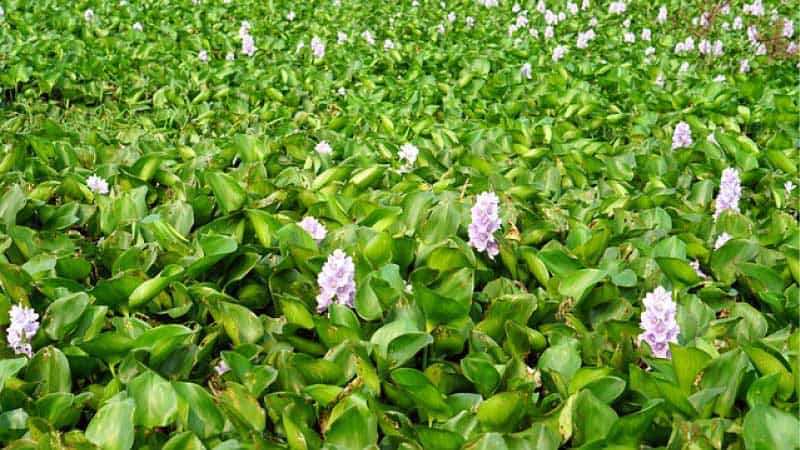
Water hyacinth is an aquatic weed with beautiful purple-coloured flowers. Water hyacinths are free-floating plants that can be found on rivers, ponds, lakes, water channels, water gardens or other freshwater sources of Asia, the USA, Europe and Africa. This is a very common aquatic weed in Bangladesh. But this plant is not native to these regions. Japanese knotweed, giant hogweed and kudzu were originated from Asia. But water hyacinth was introduced in Asia in the 19th century and it was native to Amazon Basin in South America. It was also introduced in some parts of the USA, Europe and Africa. Water hyacinth is not a problematic species for its native habitat but created huge problems in more than 50 countries. It was taken to the new habitats mostly for its beautiful flowers. Water hyacinth has many uses in Asian countries but it is a serious invasive aquatic weed there. Why water hyacinth is so invasive in new habitats?
- Water hyacinth reproduces very fast by two vegetative methods. Its colony can be doubled within one to two weeks. It also produces seeds for reproduction.
- Water hyacinth reproduces by fragmentation of stolons (runner stems). Fragmentation may occur by wind, moving propellers of motorboats, grazing by animals.
- Water hyacinth can also reproduce by producing plantlets at the base of the plant which helps them to grow their family fast.
- Water hyacinth can float easily because of their spongy stem with huge air cavity there.
- The shape of water hyacinth leaves facilitates them to spread on the water with wind.
- They can uptake nutrients from water due to their feather-like root structure.
- Water hyacinths cover the water surface within a very short time and other aquatic plants under the water as well as algae and plankton do not get proper sunlight to survive. As a result, water hyacinth lives without any competitor.
- A water hyacinth plant can produce thousands of seeds each year and these seeds can remain viable for more than 30 years. Can you imagine that?
- The natural enemies (some moths, weevils etc.) that control water hyacinth colony in South America are rare in its new habitats. That is why it has become so invasive there.
